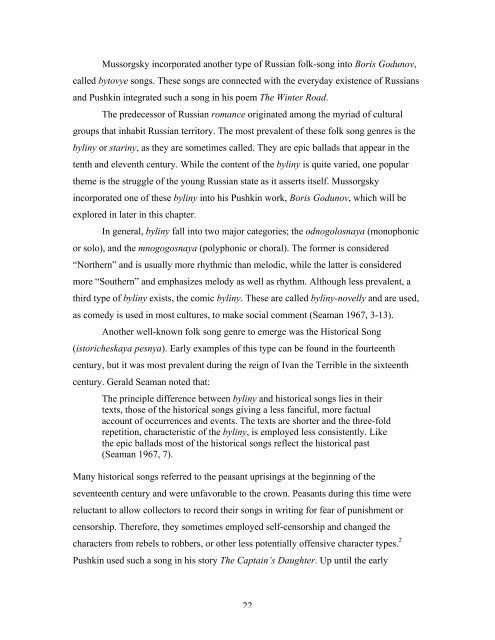Alexander Pushkin's Influence on Russian Ballet
Alexander Pushkin's Influence on Russian Ballet
Alexander Pushkin's Influence on Russian Ballet
You also want an ePaper? Increase the reach of your titles
YUMPU automatically turns print PDFs into web optimized ePapers that Google loves.
Mussorgsky incorporated another type of <strong>Russian</strong> folk-s<strong>on</strong>g into Boris Godunov,<br />
called bytovye s<strong>on</strong>gs. These s<strong>on</strong>gs are c<strong>on</strong>nected with the everyday existence of <strong>Russian</strong>s<br />
and Pushkin integrated such a s<strong>on</strong>g in his poem The Winter Road.<br />
The predecessor of <strong>Russian</strong> romance originated am<strong>on</strong>g the myriad of cultural<br />
groups that inhabit <strong>Russian</strong> territory. The most prevalent of these folk s<strong>on</strong>g genres is the<br />
byliny or stariny, as they are sometimes called. They are epic ballads that appear in the<br />
tenth and eleventh century. While the c<strong>on</strong>tent of the byliny is quite varied, <strong>on</strong>e popular<br />
theme is the struggle of the young <strong>Russian</strong> state as it asserts itself. Mussorgsky<br />
incorporated <strong>on</strong>e of these byliny into his Pushkin work, Boris Godunov, which will be<br />
explored in later in this chapter.<br />
In general, byliny fall into two major categories; the odnogolosnaya (m<strong>on</strong>oph<strong>on</strong>ic<br />
or solo), and the mnogogosnaya (polyph<strong>on</strong>ic or choral). The former is c<strong>on</strong>sidered<br />
“Northern” and is usually more rhythmic than melodic, while the latter is c<strong>on</strong>sidered<br />
more “Southern” and emphasizes melody as well as rhythm. Although less prevalent, a<br />
third type of byliny exists, the comic byliny. These are called byliny-novelly and are used,<br />
as comedy is used in most cultures, to make social comment (Seaman 1967, 3-13).<br />
Another well-known folk s<strong>on</strong>g genre to emerge was the Historical S<strong>on</strong>g<br />
(istoricheskaya pesnya). Early examples of this type can be found in the fourteenth<br />
century, but it was most prevalent during the reign of Ivan the Terrible in the sixteenth<br />
century. Gerald Seaman noted that:<br />
The principle difference between byliny and historical s<strong>on</strong>gs lies in their<br />
texts, those of the historical s<strong>on</strong>gs giving a less fanciful, more factual<br />
account of occurrences and events. The texts are shorter and the three-fold<br />
repetiti<strong>on</strong>, characteristic of the byliny, is employed less c<strong>on</strong>sistently. Like<br />
the epic ballads most of the historical s<strong>on</strong>gs reflect the historical past<br />
(Seaman 1967, 7).<br />
Many historical s<strong>on</strong>gs referred to the peasant uprisings at the beginning of the<br />
seventeenth century and were unfavorable to the crown. Peasants during this time were<br />
reluctant to allow collectors to record their s<strong>on</strong>gs in writing for fear of punishment or<br />
censorship. Therefore, they sometimes employed self-censorship and changed the<br />
characters from rebels to robbers, or other less potentially offensive character types. 2<br />
Pushkin used such a s<strong>on</strong>g in his story The Captain’s Daughter. Up until the early<br />
22

















